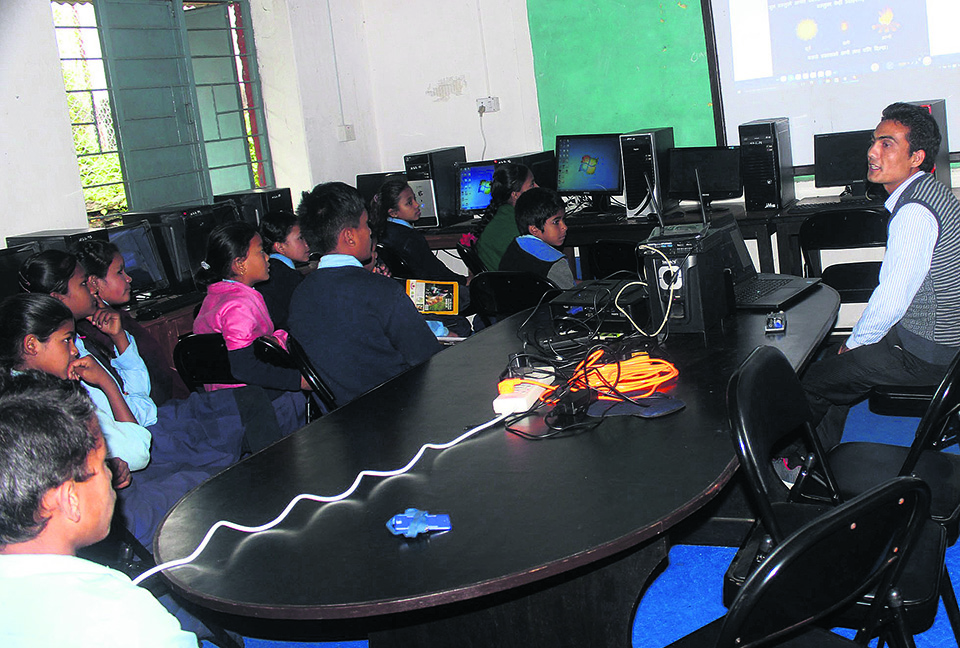
OR
Technology friendly education in rural schools
Published On: July 18, 2019 08:20 AM NPT By: CHHABILAL TIWARI

PARBAT, July 18: Technology-friendly education, which was mostly limited to schools in cities and towns until a few years ago has reached remote villages in recent years. With internet connectivity getting more comprehensive, schools in rural areas these days compete for digital excellence.
For instance, Himalaya Secondary School of Modi Rural Municipality – 3 of Parbat has not only started computer classes for its students but has also embraced teaching students with online resources and projectors. This school, which is running ‘smart classes’, is a day’s walk from the town area of Modi Rural Municipality and is situated at an altitude of 2200 meters.
“Students here do not have to take piles of books to school every day. Teachers encourage them to bring a few notes. Teachers and students search for related information and texts on the internet,” said the school’s principal Eknath Sharma. “And it works for most of the subjects. Such learning is fun for students,” he added.
Sharma stated that affluent families used to send their kids to cities for education in the past, but nowadays, the trend has changed. “Because of innovative and technology-friendly education along with other improvements, more and more students are enrolling at our school. Even parents who would send their kids to boarding schools are enrolling their kids here,” Sharma said.
This kind of change in the school has left students with all smiles. According to a 7th grader at the school Salina Gurung, learning with the help of the internet, projector and digital resources are far more effective than textbooks.
“Earlier, we would memorize lessons without understanding their essence. We used just mug up everything to spit out during exams,” Gurung said. “Entire concept about learning has changed now. Since our school introduced e-teaching, we feel so free and receptive,” she added.
Another student at the school Safal Pariyar said that she finds it very exciting to attend classes when projectors are used. Students have found freedom from the burden of carrying loads of books and notebooks to school, she noted.
“I can learn everything at once. I do not have to struggle to understand things as before,” said Pariyar. “Projectors and computers have made learning so easy.”
The school started smart teaching two years ago. In the beginning, it had a few computers donated by an organization. Soon, the school approached the local body for further help. Internet was connected, projectors were purchased. In the meantime, teachers were also provided with the necessary training.
“Then we started smart teaching from the lower classes. For all major subjects like mathematics, science or English, it has become way more effective,” Sharma reported.
Currently, the school has 16 desktop and two laptop sets while the total number of students is 129. Students take turns to use computers and laptops.
According to Rana Bahadur Pun, president of the school management committee, the challenge is the lack of teachers’ quota. Had there been a separate quota for human resources for digital teaching, the school could improve even more.
“There are many community schools these days which have been trying to go digital. Technology-based education is the need of the time, and we cannot ignore it,” said Pun.
“But finding teachers with the required soft skill is difficult. In rural areas, it is even tougher,” he added.
Despite challenges, some schools have managed to have a technology-friendly learning environment, and this is becoming a compulsion rather than choice, Pun further remarked. “If you don’t become able to walk in the pace of private schools, you lose all your students to them. So, it’s a matter of survival too, for community schools,” he stated.
There are around 16,000 files in the e-library of the school. Students go online and read any book they want. According to principal Sharma, switching to digital teaching and learning has shown excellent results. “Students’ academic performance has improved dramatically. Students who would score below 50 percent marks have now been hitting over 70 percent,” he said.
Students agree that the digital environment has made them far more interested in learning. Learning through audio and video makes things clearer. “I was very poor in mathematics earlier. But after our school started teaching through a computer, internet tips and projectors, things changed for me,” said Pariyar.
You May Like This

Rights of every student to quality education secured: Education Minister Shrestha
KATHMANDU, June 14: Deputy Prime Minister and Education Minister, Gopalman Shrestha has said that the right of every student of... Read More...

Student unions urge FM to allocate 20 pc budget for education sector
KATHMANDU, April 29: Five student unions affiliated to different political parties submitted a two-point memorandum on Sunday to Finance Minister Dr... Read More...

Koireli village in Jumla is model VAW-free village
SURKHET, Mar 25: Koireli village of Hima Rural Municipality-2 in Jumla district has been declared a model village free of violence... Read More...











Just In
- Nepal at high risk of Chandipura virus
- Japanese envoy calls on Minister Bhattarai, discusses further enhancing exchange through education between Japan and Nepal
- Heavy rainfall likely in Bagmati and Sudurpaschim provinces
- Bangladesh protest leaders taken from hospital by police
- Challenges Confronting the New Coalition
- NRB introduces cautiously flexible measures to address ongoing slowdown in various economic sectors
- Forced Covid-19 cremations: is it too late for redemption?
- NRB to provide collateral-free loans to foreign employment seekers







Leave A Comment